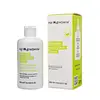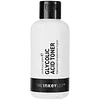What's inside
What's inside
 Key Ingredients
Key Ingredients

 Benefits
Benefits

 Concerns
Concerns

 Ingredients Side-by-side
Ingredients Side-by-side

Water
Skin ConditioningGlycerin
HumectantGlycolic Acid
BufferingPropanediol
SolventSodium Hydroxide
BufferingPhenoxyethanol
PreservativeCoptis Japonica Root Extract
Skin ConditioningPEG-60 Hydrogenated Castor Oil
EmulsifyingXanthan Gum
EmulsifyingGlycine
BufferingCaprylyl Glycol
EmollientSambucus Nigra Fruit Extract
Astringent1,2-Hexanediol
Skin ConditioningMaltodextrin
AbsorbentPentylene Glycol
Skin ConditioningCitric Acid
BufferingUrea
BufferingIllicium Verum Fruit Extract
PerfumingFructose
HumectantGlutamic Acid
HumectantLysine
Skin ConditioningLeucine
Skin ConditioningMethionine
Skin ConditioningValine
MaskingSerine
MaskingCysteine
AntioxidantAspartic Acid
MaskingAlanine
MaskingArginine
MaskingIsoleucine
Skin ConditioningTyrosine
MaskingThreonine
Phenylalanine
MaskingProline
Skin ConditioningHistidine
HumectantMaltose
MaskingSodium Lactate
BufferingSodium Chloride
MaskingSodium PCA
HumectantAllantoin
Skin ConditioningTrehalose
HumectantGlucose
HumectantSodium Hyaluronate
HumectantSodium Benzoate
MaskingPotassium Sorbate
PreservativeWater, Glycerin, Glycolic Acid, Propanediol, Sodium Hydroxide, Phenoxyethanol, Coptis Japonica Root Extract, PEG-60 Hydrogenated Castor Oil, Xanthan Gum, Glycine, Caprylyl Glycol, Sambucus Nigra Fruit Extract, 1,2-Hexanediol, Maltodextrin, Pentylene Glycol, Citric Acid, Urea, Illicium Verum Fruit Extract, Fructose, Glutamic Acid, Lysine, Leucine, Methionine, Valine, Serine, Cysteine, Aspartic Acid, Alanine, Arginine, Isoleucine, Tyrosine, Threonine, Phenylalanine, Proline, Histidine, Maltose, Sodium Lactate, Sodium Chloride, Sodium PCA, Allantoin, Trehalose, Glucose, Sodium Hyaluronate, Sodium Benzoate, Potassium Sorbate
 Reviews
Reviews

Ingredients Explained
These ingredients are found in both products.
Ingredients higher up in an ingredient list are typically present in a larger amount.
Glycolic Acid is arguably the most famous alpha hydroxy acid (AHA) with tons of research backing its benefits.
It is found naturally in sugar cane but the form used in skincare is usually synthetic for purity and stability.
Glycolic acid removes the top layer of dead skin cells to allow newer and fresher ones to emerge.
AHAs work by breaking down the structural “glue” that holds old skin cells in place. When that buildup is gone, your skin can renew itself more efficiently.
Research also shows glycolic acid stimulates collagen production, helping to firm and thicken the skin over time. This is one of its biggest advantages over other AHAs.
Overall, glycolic acid helps with:
Fun fact: Glycolic acid boosts skin hydration by helping it produce molecules that increase hyaluronic acid naturally.
To work best, glycolic acid products should have a pH between 3-4 (that’s where exfoliation is most effective but still gentle on skin).
The pH and concentration of a product are key to its effectiveness:
It is normal to feel a slight stinging sensation when using glycolic acid. This usually fades as your skin adjusts.
Because glycolic acid has the smallest molecular size in the AHA family, it can penetrate deeper, which enhances its effectiveness but also makes it more likely to irritate sensitive skin.
If your skin is very sensitive or prone to rosacea, glycolic acid may be too strong; in that case, try milder options like lactic acid or a PHA instead.
Recent studies suggest glycolic acid might even help protect against UV damage. But don’t skip sunscreen! Freshly exfoliated skin is more sensitive to the sun.
Glycolic acid is a skincare superstar. It smooths, brightens, hydrates, and firms the skin. Unless you’re highly sensitive, it’s well worth adding to your routine.
Read more about some other popular AHA's here:
Learn more about Glycolic AcidPhenoxyethanol is a preservative that has germicide, antimicrobial, and aromatic properties. Studies show that phenoxyethanol can prevent microbial growth. By itself, it has a scent that is similar to that of a rose.
It's often used in formulations along with Caprylyl Glycol to preserve the shelf life of products.
Propanediol is an all-star ingredient. It softens, hydrates, and smooths the skin.
It’s often used to:
Propanediol is not likely to cause sensitivity and considered safe to use. It is derived from corn or petroleum with a clear color and no scent.
Learn more about PropanediolSodium Hydroxide is also known as lye or caustic soda. It is used to adjust the pH of products; many ingredients require a specific pH to be effective.
In small amounts, sodium hydroxide is considered safe to use. However, large amounts may cause chemical burns due to its high alkaline.
Your skin has a natural pH and acid mantle. This acid mantle helps prevent harmful bacteria from breaking through. The acid mantle also helps keep your skin hydrated.
"Alkaline" refers to a high pH level. A low pH level would be considered acidic.
Learn more about Sodium HydroxideWater. It's the most common cosmetic ingredient of all. You'll usually see it at the top of ingredient lists, meaning that it makes up the largest part of the product.
So why is it so popular? Water most often acts as a solvent - this means that it helps dissolve other ingredients into the formulation.
You'll also recognize water as that liquid we all need to stay alive. If you see this, drink a glass of water. Stay hydrated!
Learn more about Water